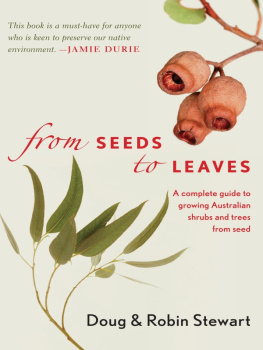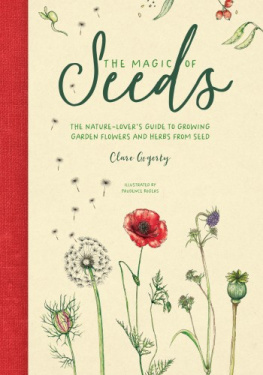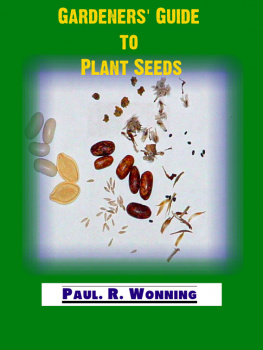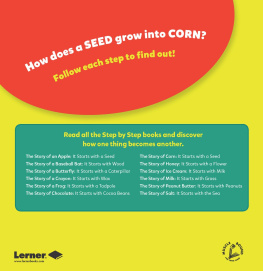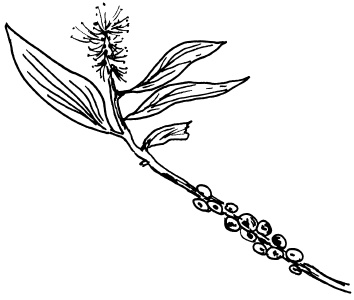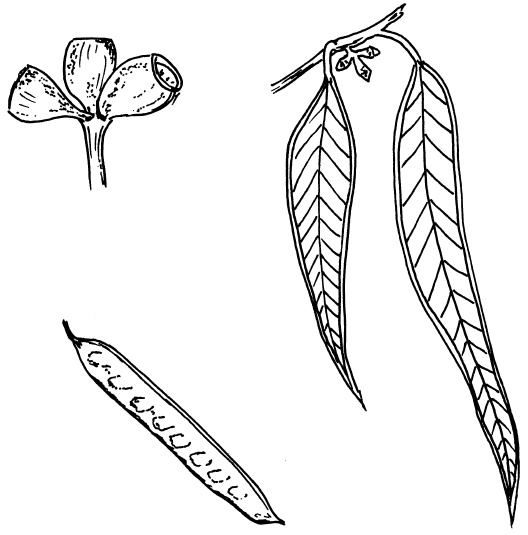I encourage everyone to take an interest in nurturing
our native gardens and parklands in this beautiful
country of ours. This book is a must-have for anyone
who is keen to preserve our native environment.
JAMIE DURIE
Other books by Robin Stewart:
Non-fiction titles for adults
The Clean House Effect
Envirocat
Chemical-Free Home
Chemical-Free Pest Control
Chasing Rainbows
The Dog Book
Australian Green Home and Garden
Tread Lightly
Childrens Books:
Moonbird
New Faces: The Complete Book of Alternative Pets (Childrens Book Council of Australia Information Book of the Year 1995)
Wombat: Bush Babies Solo Series
Koala: Bush Babies Solo Series
Charles Darwins Big Idea (short-listed for the Childrens Book Council of Australia Eve Pownall Award 2006)
Darwins Tortoise
FROM SEEDS TO LEAVES
Published by Black Inc.,
an imprint of Schwartz Publishing Pty Ltd
Level 5, 289 Flinders Lane
Melbourne Victoria 3000 Australia
email:
http://www.blackincbooks.com
Doug Stewart and Robin Stewart 2008
First published by Agmedia, 1995.
Reprinted by Bookman Press, 1999.
Illustrations on pages 25, 50, 83, 93, 102, 117, 131, 145 by Jenny Bullock.
All other illustrations by Doug Stewart.
ALL RIGHTS RESERVED.
No part of this publication may be reproduced, stored in a retrieval system, or transmitted in any form by any means electronic, mechanical, photocopying, recording or otherwise without the prior consent of the publishers.
National Library of Australia Cataloguing-in-publication data:
Stewart, Robin, 1943-. Stewart, Doug, 1945-.
From seeds to leaves: a complete guide to growing Australian trees and shrubs from seed.
Includes index
ISBN: 9781863952255
1. Shrubs - Australia. 2. Tree planting - Australia. I. Stewart, Robin E. (Robin Elaine), 1943-. II. Title.
634.95620994
Printed in Australia by Griffin Press

Seeds
The seeds I sowed
For weeks unseen
Have pushed up pygmy
Shoots of green;
So frail youd think
The tiniest stone
Would never let
A glimpse be shown.
But no; a pebble
Near them lies,
At least a cherry-stone
In size,
Which that mere sprout
Has heaved away,
To bask in sun,
And see the day.
Walter de la Mare

Preface
Seed is the germ of life, a genetic blueprint that has the potential to grow into an astonishing variety of plant life.
When it comes to seed, Nature is generous so generous that we are given opportunity upon opportunity to mend the damaging effects of unwise agricultural, mining and land management practice.
Australia is an ancient land mass that has been isolated from other continents for tens of millions of years. Our continent is composed of fragile, highly leached soils bound together by unique, varied and extraordinarily beautiful flora, including botanical curiosities of international fame, such as kangaroo paw, Sturt desert pea, banksias, waratahs, dryandras and black boys.
The conservation of our natural heritage requires careful management of our national parks, State forests and reserves, as well as the involvement of every Australian. We need long-term plans to solve critical environmental problems brought about by a mere two hundred years of white settlement.
Take a moment to imagine the concept of every Australian viewing every seed of every native plant as something precious, a life-form to be nurtured. Visualise a network of trees and shrubs linking city and country people, a green web weaving its way across our continent: wildlife corridors to preserve the wealth of our fauna and flora.
To take part in this miracle of regeneration, a simple container is all you need, for Nature provides the seed, soil, air, moisture and warmth required for germination. It will be your privilege to witness the growth of a plant from seedling stage through to flowering and seeding.
It doesnt matter if your contribution is large or small, for every seed counts. You may choose to grow native plants for your suburban garden, or you may decide to participate in a community-based conservation project.
Every single plant is important in the overall greening of our nation; every native seed represents a challenge. Will you help nurture our natural heritage?
Introduction: The challenge of climate change
Nature on the move: the new reality
Climate change is now an accepted reality that requires all of us to alter our ways and consider the environment a top priority. The wider aspects of global warming (such as melting icecaps, rising sea-levels and climate-change politics) are well covered in other books. Our primary focus will therefore be on native vegetation and the manner in which climate change affects the grasses, shrubs and trees that make up our unique ecosystems.
Everyone is familiar with the migration habits of birds and butterflies, but most people are unaware that plant species migrate too, sometimes over great distances, in order to survive.
The creation of migration corridors is vital for the survival of many plant species. Seeds need pathways along which to disperse. Pathways free of invasive weeds; pathways that offer a network of escape routes along, for example, creeks, rivers and roadsides; and pathways big enough to allow the random seeding so typical of many plants. Animal, bird, reptile, frog and insect refugees will also travel these climate-change highways, escaping from environments that were previously suitable, but which are now perhaps too warm and dry.
A race against time
Global warming requires that evolution speed up, well beyond its normal gradual rate. Climate change is warming up our planet and in doing so is forcing vegetation to move from familiar habitats to places where it has never grown before.
Some species will not be able to adapt to such rapid change and will become extinct. This is already happening. Some plants and animals will have no opportunity to migrate. In alpine ecosystems, for instance, plants will find it impossible to move higher up the mountain if they are already growing at the top! Plants indigenous to remote islands may be unable to escape due to the barrier of surrounding oceans. Other species will have their escape routes blocked off by mountain ranges, large lakes, deserts, farm-land or polluted cities.
But there will be winners, too. Some grasses, shrubs and trees will be able to expand their range, especially in northern Australia where rainfall is increasing. Some plants will migrate successfully, and some will be helped by human endeavours such as artificial seeding and mass plantings. But it will be a race against time. New ecosystems will evolve; other, more fragile ecosystems will collapse.

